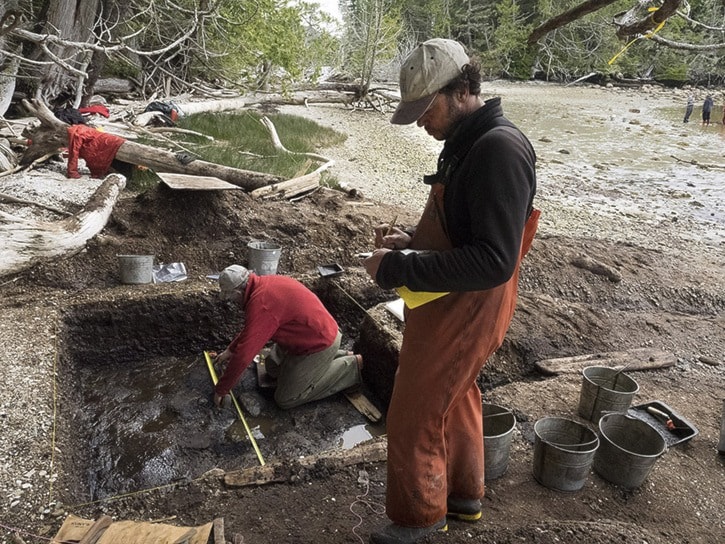Over 13,000 years ago two adults and a child walked around a fire pit on Calvert Island.
The footprints they left were embedded in soft clay near the shoreline, which was then covered with black sand. They remained hidden there until a team of archeologists led by Dr. Daryl Fedje and Dr. Duncan McLaren excavated an area just below the high tideline, unearthing a dozen human footprints impressed in clay. They are now believed to be the oldest footprints ever found in North America.
Charcoal found with the prints has been radiocarbon dated to 13,200 years ago. Adjacent samples were dated to 2,000 years ago, and additional samples are currently being processed to hone the chronology.
If the footprints can be conclusively dated to 13,200 years ago, they will be the oldest known footprints in North America, and the second oldest in the Americas after the Monte Verde site in Chile.
What makes Hakai different from so many other coastal shorelines is that sea level changes have been minimal, unlike most historical coastal settlements which were drowned by the end of the last ice age.
“Calvert Island has relatively stable shoreline history, which is very unusual,” explained Fedje.
B.C.’s Lower Mainland and Haida Gwaii have risen and dropped by more than 150 metres, washing out many potential archeological sites, but Calvert Island is the same place it was thousands of years ago, he said.
The oldest human archeological remains ever found in B.C. are from a cave in Haida Gwaii, dating to about 12,500 years ago. McLaren said he did not expect the age of the footprints to be so ancient. “This is pushing it back 700 years,” he said. “It's quite a long period of time.”
“We were very excited,” McLaren recalled. “To tell you the truth, we were a little bit surprised that we got such early dates.”
Because the dig took place less than two months ago, the team hasn't yet had the chance to get radiocarbon dates for the other footprints or publish the results in a peer-reviewed journal. But McLaren said the team decided to go public with the results because it's an exciting find and journalists had been asking about it.
He cautioned that more work is needed to confirm the results, as material found a few metres away was just 2,000 years old. But he says he's fairly confident the footprints are closer to 13,200 years old because those dates came from the footprint material itself.
The first footprint, pressed in grey clay that was covered with other sediments, was found late last year just as work was wrapping up for the autumn season.
The results prompted the team to return to Calvert Island to do a larger dig this past May.
This time, they found 12 distinct footprints belonging to a larger adult, a smaller adult and a child, and the remains of a hearth fire that the group — probably a family — had been gathered around. The hearth itself was full of charcoal and ash and ringed by rocks, including a stone tool that would have been used for chopping or cutting, McLaren said.
McLaren also said the findings have broader implications on the theories of how the first peoples arrived in North America.
McLaren says the find could provide key evidence about how the continent's first inhabitants migrated south. Older archeological remains have been found in both north of B.C., in Alaska, and south of B.C. in Oregon. It wasn't clear whether people moved from Alaska to Oregon by travelling inland on foot near the Rockies or along the coast by boat. But the new discovery favours the water route.
“There's no way to get to Calvert Island other than watercraft, and that applies to 13,000 years ago as it does today,” McLaren said.
The team plans to do carbon dating on the new footprints to ensure they can duplicate their results. They are also dating the ash from the hearth and examining it under the microscope.
The research was supported by the Hakai Institute, a research organization funded by the private, non-profit Tula Foundation. Members of the local Heiltsuk and Wuikinuxv First Nations also participated.
